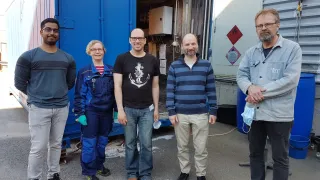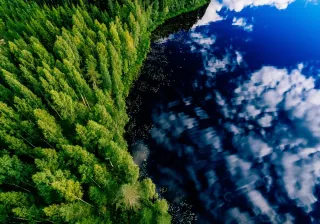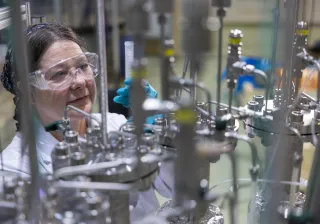Annual carbon dioxide (CO2) emissions, which are the main cause of climate change, are globally around 35 billion tonnes. Carbon capture, utilization, and storage (CCUS) has emerged as a potential technology to reduce these harmful emissions. However, the annual CO2 capture capacity from power and industrial facilities was only 40 million tonnes in 2021, equaling to 0.1 % of the total annual CO2 emissions (IEA, 2022). If significant emissions reductions are not achieved rapidly, there is an alarming need to capture CO2 from emission sources or directly from the atmosphere to address the climate crisis.
The captured CO2 can be either utilized as feedstock for products or processes, or stored permanently underground to avoid releasing the CO2 into the atmosphere. In future scenarios, utilization of CO2 as feedstock is presented to be a key element to achieve carbon neutrality, which also sets new criteria for carbon capture. Utilization of CO2 provides stricter criteria for the captured gas quality with low impurities, flows and feasibility and, thus, require novel technologies.
Development needed to produce sustainable CO2
Today, CO2 is mostly captured from flue gases of combustion processes or other similar exhaust streams, which is referred to as post-combustion capture. Different pathways for carbon capture from emission point sources can be categorized into four categories: post-combustion capture, pre-combustion capture, oxy-combustion and inherent capture. Post-combustion capture is generally end-of-pipe technology that can be integrated into existing processes without requiring major modifications, making them suitable for retrofitting.
Several techniques for CO2 capture have been developed such as liquid absorbents, solid adsorbents, membranes, cryogenic separation, chemical looping, and electrochemical separation. With liquid absorbents – that is the most common method – CO2 is caught into a liquid solution via absorption and released in a separate process phase via regeneration typically by heating the solution. Amine absorbents are commonly used due to high technological maturity and high capture performance. However, amines suffer from disadvantages such as high energy-intensity and harmful amine-based emissions, which has generated interest to develop alternative technologies that are more eco-friendly and consume less energy.
A new carbon capture method developed by VTT
An innovative bicarbonate technology for CO2 capture, which could offer a more sustainable option for amines, is being developed at VTT. Our technology utilizes an eco-friendly soda solution that is used in an enhanced way with a novel absorber configuration, speeding up dissolution of CO2 into the liquid. The soda solution can bind up to 30 times more CO2 than water, while still being almost as safe to handle as water. Furthermore, the process does not generate any harmful pollutants, which is a significant advantage over the commonly used amine absorbents.
Originally, the process was developed for biogas purification, but since potential has been recognized also in post-combustion capture. The process has been previously experimented in projects like BioMet2020 and BECCU, capturing CO2 from synthetic gas mixtures, flue gases originating from biomass combustion, and raw biogas. In E-Fuel, we aim to develop the soda process towards higher scale via process simulation and practical experiments. VTT’s test bench of TRL 5 is built into container which enables tests also on field circumstances.
How does VTT’s soda capture process work?
In the enhanced soda scrubbing process developed by VTT, an aqueous solution of sodium carbonate (Na2CO3), that is commonly known as soda, is used to capture CO2 via chemical absorption. CO2 dissolved into the solution reacts with soda and water via chemical absorption to form sodium bicarbonate (NaHCO3), i.e., baking soda. CO2 is released from the solution in a regeneration step, where the bicarbonate is converted back to carbonate at sub-atmospheric pressure and temperature of 65-75°C. After regeneration, the capture solution is cycled back to the absorption step, thus creating an efficient CO2 capture cycle with a low demand of make-up absorbent. Purity of the produced CO2 stream is over 95 vol-%, which, if needed, can be further purified by drying and nitrogen removal before transportation and/or utilization of the CO2.
To improve performance of the process, the gas-liquid mixing is enhanced with a novel microbubble generator that produces very small size bubbles which enable a large gas-liquid reaction area for efficient dissolution of CO2 into the solvent, thus enhancing CO2 absorption rate. High absorption rate decreases size of the absorber, which could potentially lower the capital costs compared to conventional absorption columns.
Absorption efficiency tests of soda capture process to pave the way towards process upscaling
For upscaling the soda capture process, process simulation and optimization of the process parameters are needed. Thus, it was important to collect data on system performance. Focus was set to absorption performance with a target to provide reliable data on mass transfer and kinetics using different flows of liquid and gas. Tests were performed during the summer of 2021 at VTT’s premises in Espoo, Finland. Synthetic gas mixtures were used in the tests as a source of CO2 and various parameters were measured (e.g., pH, flow rates, CO2 concentrations, dissolved oxygen and bubble sizes with high speed camera). The tests were made in co-operation with VTT and LUT (Lappeenranta–Lahti University of Technology) and the results were published in a Master’s Thesis.
Efficiency coefficients provide important information for process upscaling. In this case the results showed that the absorption reaction occurs so fast that extra delay time is not needed, which enables lower capital costs for the process. The results show that dissolving of CO2 is about 10 times faster to soda than to plain water. The higher value of efficiency coefficient indicates better mass transfer and by knowing the related process parameters the optimization can be done. Determination of CO2 mass transfer efficiencies for the absorption system were performed with air and with 15 vol-% CO2 gas mixture for water and 8 w-% Na2CO3 solution. Tests with air was related to standard dissolved oxygen method which is used for comparing the mass transfer efficiencies of different systems.
In order to be able to define the performance of the microbubble generator parameter’s effect to absorption efficiency, the bubble sizes and bubble velocities were estimated using high-speed camera operated by LUT (see picture below). Image recording was done at three different focal areas in a transparent pipe after micro bubble generator. By measuring an average of 20 bubbles of minimum size and 20 bubbles of maximum size the average bubble size was estimated. In soda solution the average bubble sizes were from 334 µm to 2500 µm, depending on the flow parameters. Respectively, in water the average bubble sizes were from 370 µm to 4140 µm. Together with the absorption, these results show that smaller bubbles indicate higher absorption efficiency.
Further development needs and commercial scale development
VTT’s novel soda process for carbon capture can be further developed by improving the regeneration process, optimizing the heat and flow rates, as well as by screening different heat integration options which could be used in industrial plants. Commercializing of the process has begun by Kleener Power Solutions Ltd.
Links to related Master’s thesis
Linjala, Onni. Review on Post-Combustion Carbon Capture Technologies and Capture of Biogenic CO2 Using Pilot-Scale Equipment. Lappeenranta–Lahti University of Technology LUT. 2021. https://urn.fi/URN:NBN:fi-fe202103046520
Narayanasamy, Mohankumar. Mass Transfer Efficiency for CO2 Capture Using Soda Solutions. Lappeenranta–Lahti University of Technology LUT. 2021. http://urn.fi/URN:NBN:fi-fe2021110954433
In the main photo: Test group of VTT and LUT at the test facilities in VTT Espoo, August 2021. Persons in the picture are Mohankumar Narayanasamy (LUT), Tuula Kajolinna (VTT), Kristian Melin (LUT), Andrey Saren (LUT) and Johannes Roine (VTT). Picture: VTT.
|
E-fuel project in Finland The E-fuel project of the Neste Veturi programme was launched in the beginning of 2021. It aims at the large-scale production and commercialisation of electrofuels and involves 15 partners. E-fuel is an investment of more than 6 million euros in the electrofuels development. One of the general goals of the project is to improve the post-combustion CO2 capture and purification from industrial sources for synthesis/co-electrolysis purposes. Post-combustion capture – targeting to recover CO2 from flue gases – is currently the most preferred method. As an end-of-the-pipe technology, post-combustion capture is suitable for retrofitting. E-fuels will also demonstrate the production of electrofuel on bench scale units located in sea containers using real CO2 feeds. Demonstrated concept includes CO2 capture from flue gas, hydrogen production from electrolysis, hydrocarbon fuel synthesis and end use tests of the produced electrofuel. Production technologies for electrofuels are to be commercialized together with companies in the value chain. |
Fig 1. Example of high-speed camera picture from soda solution with liquid flowrate of 15 l/min and 15 vol-% CO2 gas mixture flowrate of 10 l/min. Picture: LUT.






